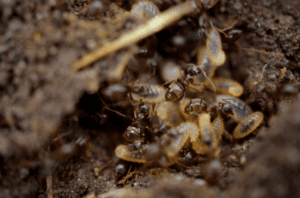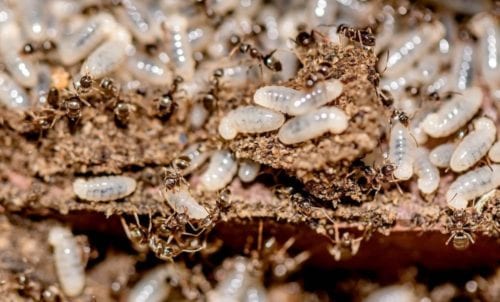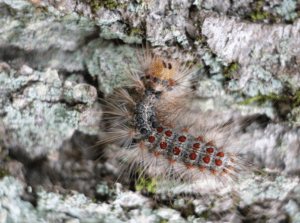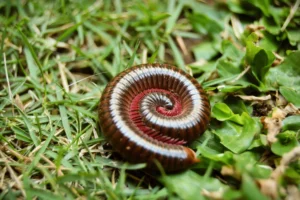

Termite Identification: Bergen County’s Guide to Termite Control
Termites in New Jersey are a common concern for homeowners, causing significant damage to wooden structures if left unchecked. One common question is, what do termites look like? Knowing how to recognize them is the first step in protecting your property. Understanding the behaviors and risks associated with these pests is crucial for protecting your property. In this article, we’ll explore important facts about termites, including how to identify infestations, the types of termites common to New Jersey, and effective prevention methods. By staying informed, you can take proactive steps to safeguard your home from costly termite damage.
Termites VS Ants: What Do Termites Look Like?
Wood-destroying pests are often mistaken for one another, and when it comes to protecting your home or business, it is important to know the difference between termites and ants. Termites are small, soft-bodied insects, typically measuring between ¼ to ½ inch in length. They are pale in color, often white or light brown, which gives them a translucent appearance. Their bodies are divided into three main parts: the head, thorax, and abdomen, but unlike ants, termites do not have a narrow, pinched waist. Their antennae are straight rather than elbowed. Reproductive termites have broad, straight wings of equal size, which they shed after swarming. Ants, on the other hand, are darker in color, often black or brown, and have a more defined, segmented body with a noticeable waist. Ants' wings, if present, show a distinct size difference between the front and hind pairs. Additionally, ants have bent or elbowed antennae, unlike the straight ones found in termites. These differences in body structure and coloration help distinguish termites from ants.
What Kind of Termites Live in New Jersey?
In New Jersey, the most problematic types of termites are subterranean termites, particularly the Eastern subterranean termite. Subterranean termites build their colonies underground and thrive in moist environments. They construct mud tubes to travel between their colonies and food sources, which often include wood in homes, fallen trees, and other cellulose-based materials. These termites feed primarily on wood, paper, and other products rich in cellulose, which is their main energy source. They can invade homes through cracks in the foundation or spaces around utility pipes, often attacking wooden beams, floors, and walls. Moisture is crucial to their survival, so they are commonly found in damp, poorly ventilated areas like basements, crawl spaces, and around leaky pipes. Left unchecked, subterranean termites can cause extensive damage to buildings and wooden structures.
Termite Life Cycle: Do Termites Fly?
The termite life cycle consists of three stages: egg, nymph, and adult. Termite eggs hatch into nymphs, which gradually develop into different castes- workers, soldiers, or reproductive termites, known as alates. Alates are winged termites. During swarming season, reproductive termites do fly, but they shed their wings after mating to start new colonies. Worker and soldier termites are wingless and do not fly at any point during their life cycle.
Identifying Signs of Termite Activity
To identify signs of termite activity, start by inspecting wooden structures for visible damage, such as hollow-sounding wood or wood that breaks easily when tapped. Termites often consume wood from the inside out, leaving behind a thin outer layer that may mask severe damage. Such damage may appear in the form of sagging floors, walls, and ceilings, or wall paint that is bubbling or peeling. Mud tubes, small earthen tunnels termites use for protection while traveling between their colony and food sources, are another key indicator. These tubes are typically found on foundations, walls, or crawl spaces. Additionally, spotting discarded wings around windowsills or near entry points is a sign of a recent termite swarm, as reproductive termites shed their wings after mating. Look for small piles of frass, or termite droppings, which resemble sawdust, near wooden areas and structures. Termites prefer dark, moist environments, so check basements, crawl spaces, and areas with water leaks. Early detection of these signs can help prevent extensive structural damage.
Termite Damage: Risks and What to Watch For
Termite infestations pose significant risks to homes and structures. The primary concern is the damage termites cause to wooden components, including beams, floors, and walls. As termites consume wood from the inside out, they can compromise a building’s structural integrity, leading to costly repairs or even making the structure unsafe. Termites can also damage furniture, books, and other cellulose-based household items, further increasing the financial burden. Although termites do not carry diseases that directly affect humans, their presence can trigger allergies or asthma in some individuals due to the dust from damaged wood or the presence of termite droppings. In cases of severe infestations, the damp, decaying conditions termites create may attract other pests or health risks, such as mold and rodents. So, while termites themselves aren’t disease carriers, their damage can indirectly create unhealthy living conditions.
Preventing Termites: DIY Deterrents
To prevent termite infestations on your New Jersey property, follow these steps:
- Remove excess moisture: Fix leaky pipes, improve drainage, and use dehumidifiers in crawl spaces and basements, as subterranean termites are attracted to moisture.
- Relocate or eliminate outdoor wood sources: Keep firewood, lumber, or other wood piles away from the foundation, and avoid using wood mulch near your home or business' perimeter.
- Seal entry points: Repair cracks in the foundation, caulk gaps around utility pipes, and seal any holes in your walls or foundation to block termite access.
- Use treated wood: When doing construction or repairs, opt for pressure-treated or naturally termite-resistant wood species, such as cedar or redwood. Consider painting any natural or untreated wood to further deter termites.
- Inspect your property regularly: Conduct routine inspections around your home or business, especially in crawl spaces, basements, and near foundations, looking for mud tubes, damaged wood, or discarded wings.
- Hire an expert: If you come across any signs of termite activity during an inspection, call a termite control expert near you right away. Termites have earned the nickname “The Silent Destroyer” because, more often than not, by the time termite activity is discovered, significant damage has already been done. If your property is at a higher risk for termite activity, you may want to consider implementing a year-round termite control plan to prevent infestations before they start.
Finding a Termite Control Expert Near You
When selecting a termite control expert, ensure they are licensed and certified to perform pest control in your area. You can start by searching for “termites inspection near me” to find local professionals who can assess your home. Look for companies with solid reputations, backed by positive reviews or recommendations from trusted sources. It's also helpful to ask the expert what do termites look like to ensure they can accurately identify an infestation. Verify that the expert offers thorough inspections and customized treatment plans tailored to your specific infestation. Ask about their experience with termite control in your region, such as knowledge of local species like subterranean termites. Ensure the company provides a written estimate, warranty options, and follow-up services for long-term prevention. A professional, transparent approach is key to effective termite management.
Twin-Boro offers the best in Bergen County termite control with the proven Sentricon Termite Baiting System, ensuring effective, eco-friendly protection. Our services are guaranteed, and we tailor every treatment plan to meet your unique needs, providing long-lasting results and peace of mind. To schedule your free termite inspection, or for inquiries about our residential and commercial pest control plans, contact us today.






